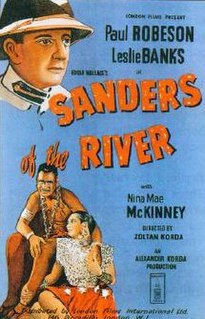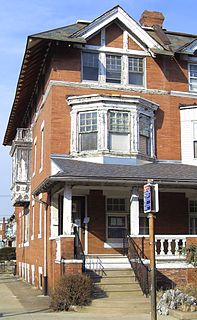
Robeson County is a county in the southern part of the U.S. state of North Carolina. As of the 2010 census, the population was 134,168. Its county seat is Lumberton. The county was formed in 1787 from part of Bladen County. It was named in honor of Col. Thomas Robeson of Tar Heel, a hero of the Revolutionary War.
The Peekskill riots were anti-communist riots with anti-black and anti-Semitic undertones that took place at Cortlandt Manor, Westchester County, New York, in 1949. The catalyst for the rioting was an announced concert by black singer Paul Robeson, who was well known for his strong pro-trade union stance, civil rights activism, communist affiliations, and anti-colonialism. The concert, organized as a benefit for the Civil Rights Congress, was scheduled to take place on August 27 in Lakeland Acres, just north of Peekskill.
"Ol' Man River" is a show tune from the 1927 musical Show Boat that contrasts the struggles and hardships of African Americans with the endless, uncaring flow of the Mississippi River. It is sung from the point of view of a black stevedore on a showboat, and is the most famous song from the show. The song is meant to be performed in a slow tempo, it is sung complete once in the musical's lengthy first scene by the stevedore "Joe" who travels with the boat, and, in the stage version, is heard four more times in brief reprises. Joe serves as a sort of musical one-man Greek chorus, and the song, when reprised, comments on the action, as if saying, "This has happened, but the river keeps rolling on anyway."

Roy Ottoway Wilkins was a prominent activist in the Civil Rights Movement in the United States from the 1930s to the 1970s. Wilkins' most notable role was his leadership of the National Association for the Advancement of Colored People (NAACP); in which he held the title of Executive Secretary from 1955 to 1963, and Executive Director from 1964-1977. Wilkins' was a central figure in many notable marches of the civil rights movement. He made valuable contributions in the world of African American literature, and his voice was used to further the efforts in the fight for equality. Wilkins' pursuit of social justice also touched the lives of veterans and active service members, through his awards and recognition of exemplary military personnel.

George Maxwell Robeson was an American Republican Party politician, lawyer from New Jersey, a brigadier general in the New Jersey Militia during the American Civil War, Secretary of the Navy appointed by President Ulysses S. Grant, serving from 1869 to 1877, and U.S. Representative for New Jersey, serving from 1879 to 1883.

Central State University (CSU) is a public, historically black university (HBCU) located in Wilberforce, Ohio, United States. It is a member-school of the Thurgood Marshall College Fund.

The People Under the Stairs is a 1991 American horror comedy film written and directed by Wes Craven and starring Brandon Adams, Everett McGill, Wendy Robie, A. J. Langer, Ving Rhames, and Sean Whalen. The plot follows a young boy and two adult robbers who become trapped in a house belonging to a strange couple after breaking in to steal their collection of rare coins.

Walnut Hill is a neighborhood in the West Philadelphia section of Philadelphia, Pennsylvania. It is located between 45th Street and 52nd Street, bounded by Market Street and Spruce Street. Most of the neighborhood is in the northwestern part of the University City District. It is located north of the neighborhoods of Garden Court and Spruce Hill.

Sanders of the River is a 1935 British film directed by the Hungarian-British director, Zoltán Korda, based on the stories of Edgar Wallace. It is set in British Nigeria. The lead Nigerian characters were played by African-Americans Paul Robeson and Nina Mae McKinney. The film proved a significant commercial and critical success, giving Korda the first of his four nominations for Best Film at the Venice Film Festival.
Paul Leroy Robeson Jr. was an American author, archivist and historian.

Eslanda "Essie" Cardozo Goode Robeson was an American anthropologist, author, actor and civil rights activist. She was the wife and business manager of singer and actor Paul Robeson.
My Song Goes Forth, is the first documentary about South Africa as apartheid was being imposed. The film features singer, actor and civil rights activist Paul Robeson singing the title song and adding a prologue that asks the viewers to interpret the remainder of the film against the producer's intentions.
Alternately entitled "Africa Sings", the initial purpose of the film was as a pro-white supremacy short-subject documentary which serves as an advertisement for the birth of apartheid in South Africa but with a conflicting message in the voice-over. Primarily the documentary has been associated with Robeson and early Anti-Apartheid activism due to his re-editing and rewriting of the films' narration.
Entertainer and activist Paul Robeson's political philosophies and outspoken views about domestic and international Communist countries and movements were the subject of great concern to the western mass media and the United States Government, during the Cold War. His views also caused controversy within the ranks of black organizations and the entertainment industry.
Paul Robeson High School for Business and Technology is a high school in the Crown Heights section of Brooklyn, New York City, New York. It is a part of the New York City Department of Education. The school is named for Paul Robeson, a singer and civil rights activist.
Paul Robeson High School for Business and Technology was opened in the building formerly called Alexander Hamilton Technical and Vocational High School named after chief staff aide to General George Washington, one of the most influential interpreters and promoters of the U.S. Constitution, the founder of the nation's financial system as the first Secretary of the Treasury of the United States. In February 1984, Alexander Hamilton Technical and Vocational High School shut its doors. Then the school reopened in the fall of 1985 with a new name—Paul Robeson High School for Business and Technology. The school, designed by Charles Snyder in the Beaux-Arts style was originally opened in 1905 as Commercial High School and housed three murals by the artist A.J. Bogdanove: Commerce, Ancient and Modern (1918) on either side of the proscenium arch of the Auditorium and Education (1924) in the front lobby currently draped over by a mural of Paul Robeson. The school was closed in 2011 due to failing ratings and has been reopened as Pathways to Technology High School.
The US congressional testimony by Jackie Robinson, the first African-American Major League Baseball player of the modern era, against the famous entertainer and international civil rights activist Paul Robeson, was an American Cold War incident. Its events were precipitated when, at an international student peace conference held in Paris on April 20, 1949, Paul Robeson allegedly made a speech to the effect that American blacks would not support the United States in a war with the Soviet Union, due to continued second-class citizen status under United States law. This subsequent controversy caused the House Committee on Un-American Activities (HUAC) to investigate Robeson and Robinson, as a famed African-American baseball player, was called on to impugn Robeson.
Paul Robeson High School is a public 4–year high school located in the Englewood neighborhood on the south side of Chicago, Illinois, United States. Opened in September 1977, Robeson is a part of the Chicago Public Schools district. The school is named in honor of African-American entertainer and athlete Paul Leroy Robeson.
Paul Robeson High School for Human Services is a district-run high school in Philadelphia with citywide admissions. The school is one of eight schools in the country that offers a focus in the human services field. The school is named after Paul Robeson.









